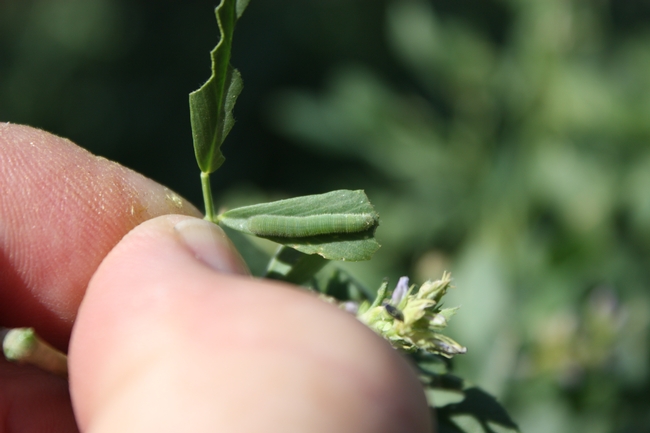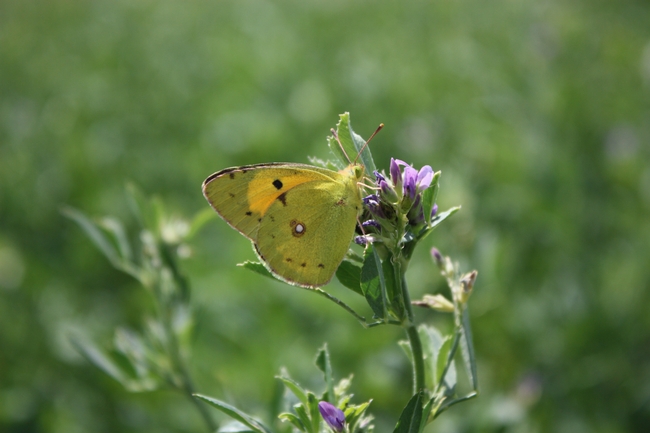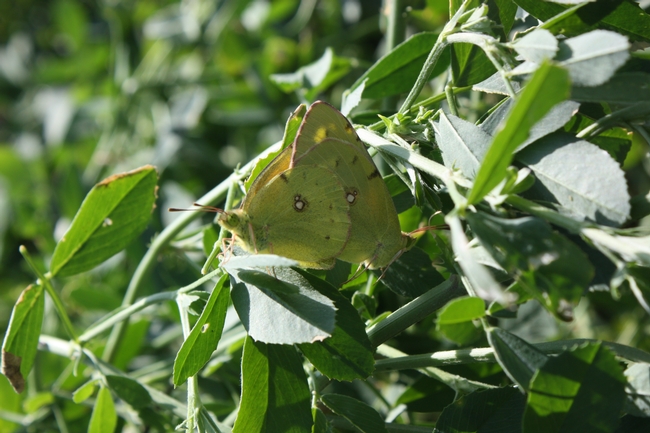Alfalfa caterpillar, Colias eurytheme, is a warm weather pest of alfalfa. Six generations of the pest may occur between May and October, in the low desert. The adults are yellow butterflies and are often called alfalfa butterflies. The abundance of alfalfa butterflies is now increasing in the low desert valleys of southern California and in the central valley of California. Alfalfa butterflies that may be flying over tall alfalfa, most likely emerged from the same field. Eggs are football-shaped and are laid singly on the upper surface of leaves in alfalfa re-growth which is up to 6 inches tall. The larvae hatch in 3 to 7 days, grow to about an inch long and pupate in approximately 2 weeks. The alfalfa caterpillar is a green larva that has a green head capsule and appears velvety due to many fine hairs covering the entire body. Mature larvae grow to about 1.5 inches long and have a single broad white stripe down each lateral side from their head to their anal end. Alfalfa caterpillars can be distinguished from other worm pests such as beet armyworm by their velvety appearance.
Alfalfa caterpillars consume the entire alfalfa leaf including the midrib. Unlike the beet armyworm, they do not skeletonize leaves. The alfalfa caterpillar can be parasitized by a small (0.25-inch long) black wasp, Cotesia medicaginis. The parasitoid wasp stings and lays an egg inside of smaller alfalfa caterpillars. As the egg hatches, the wasp larva feeds on the caterpillar’s internal body contents. A parasitized caterpillar’s color is lighter than normal, has a somewhat shiny rather than velvety appearance, and is swollen near its anal end. Pull off the caterpillar’s head capsule and squeeze out the caterpillar’s body contents checking for a white wasp larva to verify parasitism. Parasitized alfalfa caterpillars die before they reach 0.5 inch in length.
Alfalfa crop damage can sometimes be avoided by cutting hay early. The timing of early cutting is critical to avoid serious damage and at the same time obtaining satisfactory hay yield. It is important to monitor fields weekly from June through October after the regrowth reaches a height of 6 inches, checking 2 to 3 times per week during periods of heavy infestations. With a standard 15 inch diameter insect sweep net, take a 5-sweep sample in 4 to 5 locations per field, counting and recording the numbers of alfalfa caterpillars and other worm pests at each location. Check for Cotesia medicaginis parasitism. Application of insecticides may be warranted when field counts average 10 non-parasitized caterpillars per sweep. Bacillus thuringiensis (Bt) provides satisfactory control of the alfalfa caterpillar with no adverse effect on beneficial species, and no undesirable residue on the hay. Upon ingesting Bt, caterpillars cease feeding but may remain on plants 3-4 days before they die. Bt products are most efficacious when applied in the late afternoon or evening hours because Bt toxins photo-degrade when exposed to sunlight during the daylight hours. Recent insecticide efficacy trials conducted at the University of California Desert Research and Extension Center (UC DREC), El Centro, CA have also shown several other insecticides that could be used to control alfalfa caterpillars (Tables 1-3).
Table 1. Insecticide efficacies on alfalfa caterpillars, conducted at UC DREC in August of 2008.
|
|
Alfalfa caterpillars per ten sweeps |
|||||||
|
Treatment |
Rate/acre |
1DPTx |
3DATy |
7DAT |
14DAT |
21DAT |
PTA z |
|
|
Check |
--------- |
7.75 a |
0.95 a |
0.25 a |
0.75 a |
0.28 ab |
0.56 a |
|
|
Steward |
6.7 |
6.70 a |
0.03 c |
0.00 b |
0.33 b |
0.20 ab |
0.14 cd |
|
|
Lorsban Advanced |
32.0 |
6.90 a |
0.10 bc |
0.00 b |
0.25 b |
0.43 a |
0.19 bc |
|
|
Intrepid |
6.0 |
6.40 a |
0.13 bc |
0.00 b |
0.40 ab |
0.23 ab |
0.19 bc |
|
|
Intrepid |
7.0 |
6.55 a |
0.13 bc |
0.00 b |
0.10 b |
0.10 b |
0.08 de |
|
|
Baythroid XL |
2.8 |
6.85 a |
0.38 b |
0.03 b |
0.23 b |
0.43 a |
0.26 b |
|
|
Belt 480 SC |
1.0 |
6.15 a |
0.00 c |
0.00 b |
0.15 b |
0.05 b |
0.05 e |
|
|
Belt 480 SC |
2.0 |
7.85 a |
0.00 c |
0.00 b |
0.10 b |
0.18 b |
0.09 de |
|
|
Belt 480 SC |
3.0 |
7.15 a |
0.10 bc |
0.00 b |
0.13 b |
0.08 b |
0.08 de |
|
x Days Pre-treatment.
y Days after treatment.
z Post treatment average.
Means within columns followed by the same letter are not significantly different, LSD (P>0.05).
Table 2. Numbersof alfalfa caterpillar per ten sweeps following insecticide treatments at UC DREC in August 2009.
|
Treatment |
oz/acre |
3 DPTw |
3 DATx |
6 DATy |
14 DAT |
22 DAT |
PTAz |
|
Check |
--------- |
15.75 a |
10.25 a |
0.69 a |
5.75 a |
2.00 a |
5.56 a |
|
Intrepid 2F |
8.0 |
20.75 a |
0.25 b |
0.19 bc |
1.50 bc |
1.50 a |
1.00 bc |
|
Radiant |
5.0 |
9.00 a |
1.25 b |
0.08 bc |
0.75 bcd |
1.00 a |
0.81 bc |
|
Lorsban Advanced |
32.0 |
13.25 a |
0.00 b |
0.15 bc |
1.75 b |
2.50 a |
1.19 bc |
|
Cobalt |
32.0 |
14.00 a |
0.50 b |
0.00 c |
1.25 bcd |
1.25 a |
0.75 bc |
|
Baythroid XL |
2.8 |
13.00 a |
0.50 b |
0.25 b |
0.75 bcd |
3.25 a |
1.44 b |
|
Belt 480 SC |
2.0 |
14.00 a |
0.50 b |
0.08 bc |
0.25 cd |
0.00 a |
0.25 c |
|
Belt 480 SC |
3.0 |
12.50 a |
0.75 b |
0.00 c |
0.00 d |
1.00 a |
0.44 bc |
|
Belt 480 SC |
4.0 |
14.25 a |
0.50 b |
0.00 c |
0.25 cd |
0.50 a |
0.31 bc |
w Days Pre-treatment.
x Days after treatment.
y Log transformed data used for analysis.
z Post treatment Average.
Means within columns followed by the same letter are not significantly different, LSD (P>0.05).
Table 3. Mean numbers of alfalfa caterpillar per twenty sweeps at UC DREC in August 2010.
|
Treatment |
oz/acre |
1 DPTw |
2 DATx |
7 DAT |
14 DATy |
21 DAT |
PTAyz |
|
Check |
--------- |
19.75 a |
10.50 a |
7.75 a |
1.75 a |
4.75 a |
6.19 a |
|
Voliam Xpress 1.25 ZC |
5.0 |
14.75 a |
1.50 bc |
0.50 c |
1.00 ab |
4.75 a |
1.94 bc |
|
Voliam Xpress 1.25 ZC |
7.0 |
14.75 a |
1.75 b |
0.00 c |
0.00 c |
2.50 a |
1.06 cd |
|
Voliam Xpress 1.25 ZC |
9.0 |
17.75 a |
0.50 bc |
0.75 c |
0.25 bc |
5.75 a |
1.81 bcd |
|
Warrior II 2.09 CS |
1.92 |
13.25 a |
0.50 bc |
4.00 b |
0.75 abc |
7.50 a |
3.19 b |
|
Intrepid |
8.0 |
19.00 a |
0.25 bc |
0.50 c |
0.25 bc |
5.50 a |
1.63 bcd |
|
Belt 480 SC |
2.0 |
12.75 a |
0.00 c |
0.00 c |
0.00 c |
3.00 a |
0.75 d |
|
Belt 480 SC |
3.0 |
24.00 a |
0.50 bc |
0.50 c |
1.00 ab |
1.00 a |
0.75 cd |
|
Belt 480 SC |
4.0 |
20.00 a |
0.25 bc |
0.00 c |
0.25 bc |
2.75 a |
0.81 cd |
w Days Pre-treatment.
x Days after treatment.
y Log transformed data used for analysis, but actual means reported.
z Post treatment Average.
Means within columns followed by the same letter are not significantly different, LSD (P>0.05).

